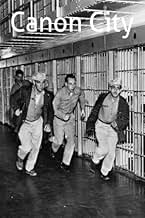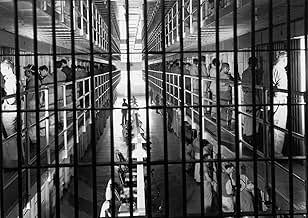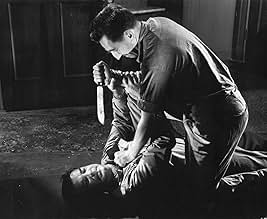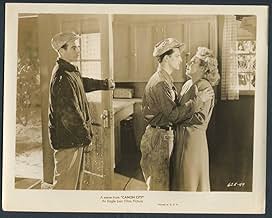Twelve inmates plan a prison break from the Colorado State Penitentiary but one of them reluctantly joins the group.Twelve inmates plan a prison break from the Colorado State Penitentiary but one of them reluctantly joins the group.Twelve inmates plan a prison break from the Colorado State Penitentiary but one of them reluctantly joins the group.
Reed Hadley
- Narrator
- (voice)
- Director
- Writer
- All cast & crew
- Production, box office & more at IMDbPro
Featured reviews
This movie proudly bears the label of a semi-documentary and comes complete with the usual Foreword about all the incidents being portrayed exactly as they happened, and all photographed on their actual locations, using real warders, guards and convicts, etc.
Personally, I doubt that the movie was shot in its entirety inside the actual prison there's even a credit for 2nd unit direction and photography. But be this as it may, the studio material is certainly extremely well integrated with the location footage. Credit for this achievement is mostly due to John Alton, whose masterful photography makes Canon City must watching for connoisseurs. True, Alton's work here is less tantalizing than usual as he was required to match up his shots with Strenge's rather dull location work. Nonetheless, there are still more than a few indications (the profile silhouette on Brady's face) of genius behind the camera.
Crane Wilbur's screenplay is less praiseworthy, but typical of that writer's detached, tabloid newspaper-style approach. He loves the sort of narrated rhetoric employed by contemporary newsreel commentators (Reed Hadley does a good job here with the actual narration), but fortunately his dialogue is less flowery and more realistic.
Generally Wilbur's direction rates as rather dull, but here his handling is even occasionally inventive, although his experiments are not always successful (as for example in the oddly oblique use of the first-person camera right at the beginning, with the on-screen characters swapping words with the disembodied narrator).
In all, however, the film emerges as a reasonably engrossing prison melodrama, convincingly acted (except oddly by the non-professionals), compellingly photographed, and tautly written. Despite its foregone conclusion, the storyline does build up a moderate amount of excitement and tension.
Personally, I doubt that the movie was shot in its entirety inside the actual prison there's even a credit for 2nd unit direction and photography. But be this as it may, the studio material is certainly extremely well integrated with the location footage. Credit for this achievement is mostly due to John Alton, whose masterful photography makes Canon City must watching for connoisseurs. True, Alton's work here is less tantalizing than usual as he was required to match up his shots with Strenge's rather dull location work. Nonetheless, there are still more than a few indications (the profile silhouette on Brady's face) of genius behind the camera.
Crane Wilbur's screenplay is less praiseworthy, but typical of that writer's detached, tabloid newspaper-style approach. He loves the sort of narrated rhetoric employed by contemporary newsreel commentators (Reed Hadley does a good job here with the actual narration), but fortunately his dialogue is less flowery and more realistic.
Generally Wilbur's direction rates as rather dull, but here his handling is even occasionally inventive, although his experiments are not always successful (as for example in the oddly oblique use of the first-person camera right at the beginning, with the on-screen characters swapping words with the disembodied narrator).
In all, however, the film emerges as a reasonably engrossing prison melodrama, convincingly acted (except oddly by the non-professionals), compellingly photographed, and tautly written. Despite its foregone conclusion, the storyline does build up a moderate amount of excitement and tension.
A fine prison break movie from Crane Wilbur by way of Eagle-Lion Pictures, Canon City is a very good, tense film, based on a true incident, about a group of men who break of of the eponymous state prison, where the movie was also filmed. There is particular emphasis on two escapees, a reluctant one who is basically a decent guy, and a more aggressive one, who isn't. As portrayed by Scott Brady and Jeff Corey these characters come to life and compel our interest, and in Brady's case sympathy.
As photographed by the masterful John Alton, the picture is a pleasure to watch, as Mr. Alton was a master of light and shadow, and is obviously in his element with this dark story. He brightens things up in the end with a snowstorm, which enables the picture to end on a grace note, and even a feeling of optimism, not wholly justified by the events we have just witnessed.
As photographed by the masterful John Alton, the picture is a pleasure to watch, as Mr. Alton was a master of light and shadow, and is obviously in his element with this dark story. He brightens things up in the end with a snowstorm, which enables the picture to end on a grace note, and even a feeling of optimism, not wholly justified by the events we have just witnessed.
Canon City (1948)
A simple loud warning up front--the first twenty minutes or so is a horrible, stiff, documentary kind of lead-in to the movie proper. When the dramatic action gets going, it becomes fully a movie with suspense, character, speed, and even at times complexity. In fact, you could even fast forward to where you see the buy in the jail cell doing a model of a ship.
The stuff before that is not needed. It tells us what we already know about prison, though it seems to use real inmates in brief interviews, as if to set up the later jailbreak as something more tangible and believable.
It isn't giving anything away to say that some inmates escape--that's the whole hook of the movie--and then what happens to each group or individual in their attempts to get out of Canon City is what drives the movie in a series of somewhat independent vignettes. The encounters with regular town people in their homes is a little contrived but also has the edge of fear to it, and suspense. It works pretty well, the cops gradually closing in on this or that escapee.
The end result is still almost a public relations piece about the prison system, about ordinary Americans who rise up and do heroic things, and about the different kinds of attitudes of the inmates, who are people after all. I actually liked the second half of the movie, even it it wasn't completely original or brilliant. The acting is meant to be believable in a vernacular kind of way, and it is. Give it a look, especially if you like prison flicks.
A simple loud warning up front--the first twenty minutes or so is a horrible, stiff, documentary kind of lead-in to the movie proper. When the dramatic action gets going, it becomes fully a movie with suspense, character, speed, and even at times complexity. In fact, you could even fast forward to where you see the buy in the jail cell doing a model of a ship.
The stuff before that is not needed. It tells us what we already know about prison, though it seems to use real inmates in brief interviews, as if to set up the later jailbreak as something more tangible and believable.
It isn't giving anything away to say that some inmates escape--that's the whole hook of the movie--and then what happens to each group or individual in their attempts to get out of Canon City is what drives the movie in a series of somewhat independent vignettes. The encounters with regular town people in their homes is a little contrived but also has the edge of fear to it, and suspense. It works pretty well, the cops gradually closing in on this or that escapee.
The end result is still almost a public relations piece about the prison system, about ordinary Americans who rise up and do heroic things, and about the different kinds of attitudes of the inmates, who are people after all. I actually liked the second half of the movie, even it it wasn't completely original or brilliant. The acting is meant to be believable in a vernacular kind of way, and it is. Give it a look, especially if you like prison flicks.
I've lived in Canon City, Colorado for the last five years or so, and the experience of watching the film is a unique, slightly surreal one for me. Not only does the film take place in my tiny little town in the middle of nowhere, it takes place in MY NEIGHBORHOOD! The prison is a mere two blocks from my house, the movie theater three blocks, the Elk's Club where the prison guards eat in the film is right next door to the restaurant where I work. Seeing these familiar landmarks (as well as the fantastic shot of Main Street, which has aged little) gives me a small rush, and makes me inclined to declare CANON CITY an under-appreciated cult classic. Without the haze of nostalgia, I realize that the film, while certainly competent, is one of a series of mostly-forgotten B-pictures, focused on mostly by film nerds like me. I was actually quite impressed with the cinematography and lighting, which was surprisingly sophisticated and compelling, and the film rarely drags, but it just feels kinda same-y. Still, how cool is it that I'm still seeing movies in that old theater that's showing Abbott and Costello in 1948?
Noirish docu-drama based on 1947 Colorado State Prison break.
The movie's best parts are the location shots in and around the Colorado State Pen. We get at least a flavor of prison routines and the small town atmosphere. At the same time, the chase sequence at the Royal Gorge provides a scenic, if fictionalized, passage. Then too, ace photographer Alton's studio recreation of the actual winter-time blizzard lends good noirish atmosphere. There's also some tension around convict Schwartzmiller's home invasion; otherwise, the movie's a pretty routine slice of thick ear.
To me, the screenplay surrounding the break and its aftermath seems muddled. Scenes follow in no particular developmental order. Characters are glimpsed and then dropped. It may be that writer Wilbur felt constrained by the film's factual basis and hurry-up schedule. After all, the movie wrap-up came only four months (January-May) after the breakout itself. (Contrast this rather disjointed narrative with the streamlined smoothness of the fictional, albeit thematically similar, Crashout {1955}.)
As a youngster growing up a few miles from Canon City, I still have a recollection of the hubbub surrounding the breakout. The name Sherbondi suddenly became a household alarm, though I'm not sure he was the sympathetic character of the screenplay. Guns abruptly sprouted across the Arkansas (river) Valley like deer season. Speaking of those memorable few days, I'm glad the movie re-creates the blizzard that certainly hampered the getaway. That rural part of the state seldom made Denver news, let alone national headlines. So it was a pretty big deal for us living there. (In passing--- Warden Roy Best, featured in the movie, later suffered big professional damage when his liberal use of a whipping post for unruly prisoners got statewide exposure.)
Choppy narrative and personal recollections aside, the film remains an interesting example of noirish docu-drama, which the results here strongly resemble.
The movie's best parts are the location shots in and around the Colorado State Pen. We get at least a flavor of prison routines and the small town atmosphere. At the same time, the chase sequence at the Royal Gorge provides a scenic, if fictionalized, passage. Then too, ace photographer Alton's studio recreation of the actual winter-time blizzard lends good noirish atmosphere. There's also some tension around convict Schwartzmiller's home invasion; otherwise, the movie's a pretty routine slice of thick ear.
To me, the screenplay surrounding the break and its aftermath seems muddled. Scenes follow in no particular developmental order. Characters are glimpsed and then dropped. It may be that writer Wilbur felt constrained by the film's factual basis and hurry-up schedule. After all, the movie wrap-up came only four months (January-May) after the breakout itself. (Contrast this rather disjointed narrative with the streamlined smoothness of the fictional, albeit thematically similar, Crashout {1955}.)
As a youngster growing up a few miles from Canon City, I still have a recollection of the hubbub surrounding the breakout. The name Sherbondi suddenly became a household alarm, though I'm not sure he was the sympathetic character of the screenplay. Guns abruptly sprouted across the Arkansas (river) Valley like deer season. Speaking of those memorable few days, I'm glad the movie re-creates the blizzard that certainly hampered the getaway. That rural part of the state seldom made Denver news, let alone national headlines. So it was a pretty big deal for us living there. (In passing--- Warden Roy Best, featured in the movie, later suffered big professional damage when his liberal use of a whipping post for unruly prisoners got statewide exposure.)
Choppy narrative and personal recollections aside, the film remains an interesting example of noirish docu-drama, which the results here strongly resemble.
Did you know
- TriviaFilm debut of Scott Brady.
- GoofsImmediately after the prison break, there's a shot of a crowd of people leaving a movie theatre, with Abbott & Costello in 36 heures à vivre (1948) (another Eagle-Lion release) prominently displayed on the readerboard. Only problem is, the break took place 30 December 1947, and The Noose Hangs High wasn't released until the end of the following April.
- ConnectionsReferenced in Let's Go to the Movies (1949)
Details
Box office
- Budget
- $424,000 (estimated)
- Runtime
- 1h 22m(82 min)
- Color
- Aspect ratio
- 1.37 : 1
Contribute to this page
Suggest an edit or add missing content






















